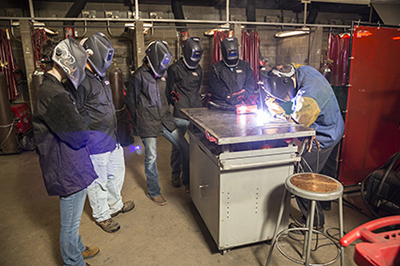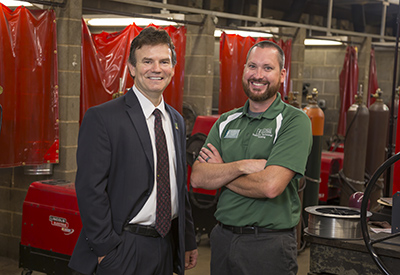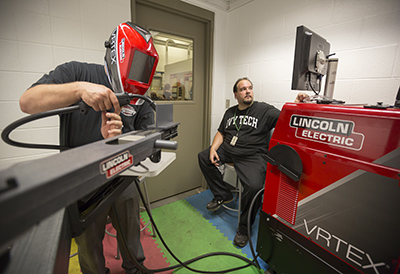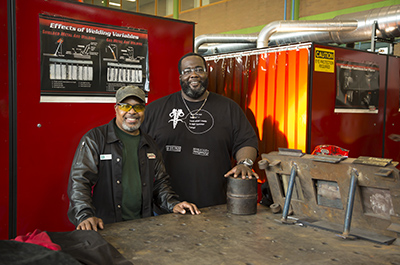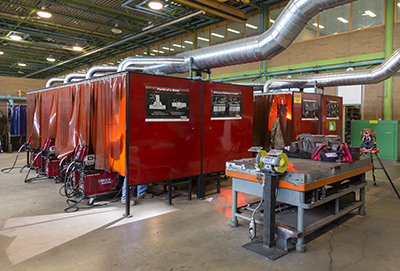IVY TECH COMMUNITY COLLEGE BUILDS A NEW GENERATION OF WELDERS WITH STATE OF THE ART TRAINING TECHNOLOGY
Ivy Tech Community College, with 170,000 students at 32 campuses in Indiana, has been named the top two year institution four years in a row.
With thousands of skilled welders aging out of the labor pool, Indiana-based Ivy Tech Community College is building a new workforce for the 21st century – not just for the school’s home-state, but for much of the upper Midwest. They’re doing it with the help of equipment and technology from Lincoln Electric®.
Established in 1963 as Indiana Vocational Technical College, Ivy Tech is Indiana’s largest public post-secondary institution and the nation’s largest singly accredited statewide community college. Ivy Tech has 32 campuses around the state and offers more than 150 programs. Every year, the school serves more than 170,000 students who earn both certificates and associate degrees.
Ivy Tech has about 12,000 students in technical programs, with approximately 1200 studying welding at more than 20 of its campuses throughout Indiana.
In November 2016, for the fourth year in a row, Community College Week named Ivy Tech the top two-year institution in the U.S. that awards associate degrees. In the 2014-2015 academic year, Ivy Tech awarded 9,954 associate degrees – a 5-percent increase over their previous year, and almost double the second-ranked two-year institution, Houston Community College.
“We have about 12,000 students in our technical programs,” says Glen Roberson, Assistant Vice President of Technology Programs at Ivy Tech. "About 1200 of those are welding students who are pursuing either a technical certificate or an associate degree in welding." He adds that 20 of the Ivy Tech campuses run welding programs, and similar programs are planned for two additional campuses next year.
Ivy Tech's Glen Roberson and Bryce Eaton.
Much of what’s driving Ivy Tech’s welding training initiative is the evolution of the statewide labor pool in the manufacturing sector in recent decades. At the local Subaru plant in Lafayette, Indiana, for example, 35 percent of the overall workforce is currently eligible for retirement, according to Bryce Eaton, Program Chair of Advanced Automation Robotics Technology/Welding at Ivy Tech. Many of those jobs start as high as $25 per hour, he says, and the story at other Indiana-based manufacturers is similar to Subaru’s.
“Recruitment is something we’re really focused on," says Eaton, who teaches at Ivy Tech’s Lafayette Campus. "We’re trying to make students aware that these opportunities are available…We’re going to have to replace those workers, whether they be at Subaru, or places like Wabash National or Caterpillar. We’re doing our best to partner with these companies and align our curriculum with what they’re asking for and what they’re doing so we can be a feeder program for them."
First steps
Ivy Tech starts students at the very beginning. Even before the welding training gets under way, students who are still early on the experience curve can take a welding fundamentals course called Weld 100. This recently developed course focuses on OSHA safety, blueprint reading, proper use of hand tools and other basic skills. Following the Weld 100 course, students take two levels of MIG, TIG, and stick welding training. At the end of the second level, students have the opportunity to either pursue AWS certification or take further coursework in pursuit of an associate degree.
At every step, Lincoln Electric’s VRTEX® virtual reality training technology is part of the Ivy Tech curriculum. The school started buying VRTEX systems three years ago, and currently has more than 30 VRTEX Mobile and VRTEX 360 units at campuses throughout the state.
Every student begins the Weld 101 class with up to two weeks on the VRTEX 360 virtual reality welding simulator to practice position, angles and travel speed without burning plate, rod, wire or shielding gas.
"In the Weld 100 course, we give students a taste of MIG welding and stick welding with the VRTEX simulator,” says Eaton. Further into the program – in the courses dedicated to MIG, TIG and stick welding – the VRTEX system’s visual cues are often more effective than a demonstration by an instructor, he adds. He cites the E6010 electrode whip-and-pause technique as an excellent example.
"You can try to explain the whip-and-pause technique to someone," says Eaton, "but until they see it, or until they do it, they’re not going to fully understand what that is. If I do it live with real welding, they’re not going to be able to see the arc like they do on the simulator. It will show them how far to whip, how long to pause, etc."
Parnell Jordan, Program Chair of Industrial Technology/Welding at Ivy Tech’s East Chicago Campus, describes himself as being "from the old school." As such, he was initially skeptical of the VRTEX simulators. But the ability of VRTEX to help students develop technique and muscle memory, and get a better handle on skills related to angle and travel speed, accelerates student development and reduces costs at the same time.
Parnell Jordan (left) leads the welding instruction team at the Ivy Tech East Chicago location where every student spends time at the VRTEX 360 virtual reality welding simulator system.
"At first, I thought the money could have been spent somewhere else within the welding lab," says Jordan. "But after trying the VRTEX, and giving the students a chance to spend some time on them, we saw an impressive degree of progress. We’ll let a student use the VRTEX for two weeks, and then bring them out to the lab to do some real welding. They tend to grasp the concept in the lab a lot faster than they did with our traditional style of teaching before we used the VRTEX. It definitely speeds up the learning process."
In addition to enhancing curriculum, VRTEX also reduces costs by sidestepping the expense of materials like plate, welding rod or wire and shielding gas in the early stages of training. In fact, cost reduction was one of the primary drivers behind Ivy Tech’s initial investment in VRTEX technology three years ago.
"In the past three years, we have seen a reduction of well over 20 percent of what our consumable fees have been budgeted for," says Roberson. "We also know that the other values added are the recruitment, the students’ excitement of being able to work on the simulators and have competitions. Those types of things are values that we can’t put a price on."
The Lincoln alliance
VRTEX is just one component in the array of Lincoln Electric products used in Ivy Tech’s welding training program statewide. The school also uses Power MIG® and Square Wave® welders, Power Wave® technology and Torchmate® CNC plasma cutting tables in its curriculum at many of the locations where welding training is offered. Portable robotic welding education cells with Fanuc® robots, industry’s most common robot supplier, are also moving into Ivy Tech’s curriculum. The robotic welding cells have crossover potential for use in other programs within the Ivy Tech system, such as manufacturing technology.
Ivy Tech uses the VRTEX welding simulator to help introduce concepts and techniques that are difficult to explain in an actual welding booth.
“Our advisory boards have given us strong recommendations on the plasma cutters and the robotic welders,” says Roberson. “We have plasma cutters in almost all regions now, and we’re trying to budget to have all of the welding robots in the regions in the next three to five years. We are partnered with Fanuc, which is part of the Lincoln Electric program, and we have more than 20 of our instructors who are certified in Fanuc robotic operations. We have more than 25 Fanuc production robots throughout the state as well. So it’s going to be a nice addition to have our welding portion in our manufacturing cell. That way, not only welding students can take advantage of the state-of-the-art technology, but our robotics and our industrial tech programs and our engineering and techprograms will all still benefit from this."
The partnership actually began eight years ago, when Eaton first came on board as an Ivy Tech instructor. The faculty sat down with Lincoln Electric and other suppliers and essentially issued a challenge.
“We said, ‘This is what we are and this is what we do. What services can you provide for us?’” Eaton recalls. “It started there, and it has evolved over time. I can call Lincoln Electric and they will immediately answer the phone, and we can get things taken care of right away. With some of the other suppliers, it just doesn’t work like that. Lincoln is very good at customer service. We’ve never had a problem with them, and that’s why we continue to buy.”
Lincoln Electric’s reduced pricing on welding consumables offered to educators through the company’s online Education Portal “has been a huge cost savings,” says Eaton, “which allows our budget to go a little bit further – which means buying more up-to-date equipment. That’s why we’ve been able to get things like the robot, the CNC plasma cutting table and up-to-date welding equipment that our students are going to find when they go to work in the industry.”

Ivy Tech has reduced program costs by purchasing consumables and supplies at the Lincoln Electric Education Portal.
The Ivy Tech experience
It’s hard to know who benefits more from the Ivy Tech experience – the students or the teachers. Mark Antrim has been taking courses at the Valparaiso Campus for the last two years. Restoring vintage cars had been his hobby for many years prior to that, but he enrolled at Ivy Tech to polish some of the MIG, TIG and stick welding skills he’d taught himself along the way. The formal training with quality equipment and systems has upped his game.
"The idea was to come here to school and really learn the process, and have a better sense that I’m able to do it professionally, rather than just taking spare metal and welding something together,” says Antrim. “Learning on the right equipment is definitely a plus. I used the Chinese stuff before, when I was first learning how to weld, and it was frustrating. The setting weren’t right. It wouldn’t weld properly. So to actually come in here and use the equipment that we have at Ivy Tech, and to see it put down a perfect weld – it’s like night and day."
Doug McKiddy, one of the lead welding instructor at the Valparaiso Campus, insists that the pleasure is all his. “It’s that look they get on their face when you know they understand,” he says of his students. “It’s that ‘ah-ha’ moment, that moment when they realize, 'I got it!' That’s the biggest perk you’re ever going to get on this job."
Some students who graduate out of Ivy Tech and move on to jobs and careers with more and better options come back, says Eaton, but not necessarily for more training.
"Occasionally they’ll check in just to thank us for guiding them, and at times being strict with them rather than just letting them do things their own way,” he says. "We make sure that they stay focused, that they stay on task, when they’re here. It’s easy for them to get frustrated as they’re learning, but we do our best to try to prevent that. Recently I did have a student come back in after getting a job locally. He just wanted to thank us for keeping him on track, because without that, he would have been on a much different path in his life."


